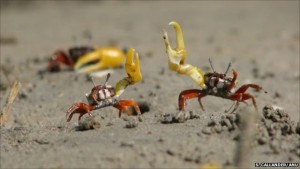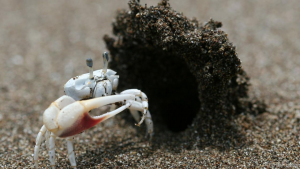Meet our friend Uca terpsichores, known commonly as a type of fiddler crab. Fiddler crabs are a group of small crabs that may be found in shallow waters of oceans, swamps, mangrove, and lagoons. They are known for the funny, uneven appearance of males, who generally posses one very large, and one very small claw. Female fiddler crabs have two, similarly medium-sized claws, making this what scientists call a sexually dimorphic trait.

Here, two male fiddler crabs compete for mating rights. Notice the characteristic enlarged single claw.
Another curious trait of the male fiddler crab is that during mating season, about 10-40% of individuals will construct a decorative hood above their burrow. This burrow is built to attract mate-ready females to an individual male’s burrow, and hence, increases the likelihood that the two will meet and mate.
While foraging, fiddler crabs of both sexes look for protection from predators and the elements in the form of small shelters along the ocean-(or lake, or lagoon, etc.) floor. So, males’ building sand hoods above their burrows exploits the pre-existing bias of females to seek out shelter while foraging. Exploiting a pre-existing bias that evolved for one reason (in this case, looking for safe hiding spots while foraging) in another, non-related circumstance (attracting a mate) is called a sensory trap. And in the case of fiddler crabs and their sand hoods, it is a very effective one—males who build hoods are significantly more likely to attract a mate because females naturally prefer burrows with hoods, and will often remain there to lay her eggs.

A fiddler crab standing at the ready near the hood of his burrow. These sand hoods attract female attention, and, new research finds, emboldens male exploration.
However, recent research by Tae Won Kim and John Christy suggests that these hoods have more than one function. In addition to attracting females, these burrows also serve as a beacon to the males who built them. That is, males have extremely poor eyesight, and can only spot their burrows about two body lengths away, on average. The hoods aid in making the burrows more visible from long distances, which in turn allows males to travel more freely along the ocean floor.
Kim and Christy found that crabs with hoods traveled significantly further away from their burrows and were able to find them again more quickly, emboldening them to explore larger distances, and subsequently enabling their meeting more females.
To conclude, male fiddler crabs are more likely to find mates when they build hoods above their burrows for both “domestic” and “abroad” incentives. Females are drawn to the shelter aspect of a hood, and males are able to explore outside of their domain more freely.
